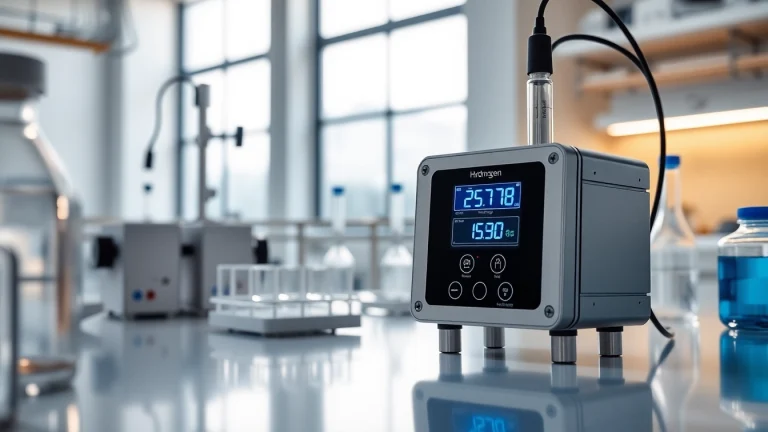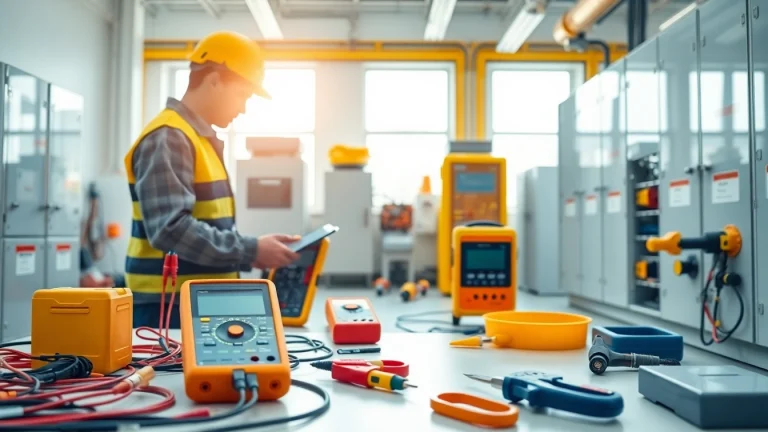
Essential Insights on Hydrogen Monitors: How They Enhance Safety and Efficiency
Understanding Hydrogen Monitors
What is a Hydrogen Monitor?
A hydrogen monitor is a specialized device designed to detect and measure the concentration of hydrogen gas in various environments. These monitors are essential tools in industries where hydrogen is used, generated, or stored, such as chemical manufacturing, petrochemical refineries, and laboratories. The primary function of a hydrogen monitor is to ensure safety by providing real-time data about hydrogen levels, which is crucial due to hydrogen’s flammability and potential hazards associated with its accumulation.
The Importance of Hydrogen Monitoring in Industries
In industrial settings, hydrogen monitoring is critical for several reasons. Hydrogen is a colorless, odorless gas that can pose significant safety risks if not managed properly. An effective hydrogen monitor mitigates these risks by providing early detection of hydrogen leaks, allowing for timely intervention before dangerous situations arise. Moreover, compliance with safety regulations and industry standards necessitates the implementation of appropriate monitoring solutions to protect workers and facilities. Additionally, monitoring hydrogen levels can prevent costly downtime and equipment damage that may occur from unaddressed leaks or high concentration levels.
Key Features of Effective Hydrogen Monitors
An effective hydrogen monitor should encompass several key features to ensure reliable performance:
- Sensitivity: The ability to detect low levels of hydrogen concentration is paramount. A sensitive monitor can help identify leaks before they pose a serious risk.
- Response Time: Fast response times are essential for safety, allowing for immediate action to be taken in case of an emergency.
- Ease of Use: User-friendly interfaces and clear readings ensure that personnel can easily operate the device and interpret the data.
- Durability: Hydrogen monitors should be robust and capable of withstanding harsh industrial environments, including exposure to chemicals and extreme temperatures.
- Data Logging: Advanced monitors often include data logging features that allow for ongoing analysis and review of hydrogen levels over time.
Types of Hydrogen Monitors
Portable vs. Fixed Hydrogen Monitors
Hydrogen monitors can be categorized into two primary types: portable and fixed. Portable hydrogen monitors are compact and battery-operated, making them ideal for use in various locations within facilities or in the field. They are particularly useful for personnel conducting inspections or maintenance work, as they can easily be moved to different zones where hydrogen is present.
On the other hand, fixed hydrogen monitors are installed permanently in specific locations, typically in areas where hydrogen is produced, processed, or stored. Fixed monitors provide continuous monitoring and can be integrated into larger safety systems that trigger alarms and emergency protocols in response to detected hydrogen levels.
Digital vs. Analog Hydrogen Monitors
Another way to differentiate hydrogen monitors is between digital and analog models. Digital hydrogen monitors use electronic sensors and microprocessors to provide precise measurements and often have advanced features like data logging, wireless connectivity, and interactive displays. These digital devices offer enhanced accuracy and real-time data visualization that is helpful for operators.
Conversely, analog hydrogen monitors use traditional measurement techniques based on physical indicators, such as gauges and dials. While they may be less expensive and require less maintenance, analog monitors typically lack the advanced features and accuracy of their digital counterparts. However, they can still be useful in certain low-tech environments where digital technology may not be feasible.
Choosing the Right Type for Your Needs
When selecting a hydrogen monitor, it is crucial to consider your specific needs and operational environment. Factors to assess include the frequency of hydrogen exposure, the required sensitivity level, and budget constraints. For mobile operations, a portable model may be more appropriate, whereas fixed installations are better suited for high-risk areas. If data analysis is essential, then opting for a digital monitor with advanced capabilities can enhance safety and compliance.
Installation and Calibration of Hydrogen Monitors
Steps for Proper Installation
Proper installation of hydrogen monitors is critical for obtaining accurate readings and ensuring safety. Here are the essential steps for effective installation:
- Select the Location: Choose locations where hydrogen leakage is likely, such as near valves, pumps, and other equipment.
- Mount the Device: Follow the manufacturer’s guidelines to securely mount the monitor. Ensure it is positioned at the appropriate height and angle for optimal detection.
- Connect Power and Sensors: Depending on the model, connect the necessary power supply and ensure all sensors are correctly calibrated and functioning.
- Run Initial Tests: Conduct initial tests to verify that the monitor is operational and providing accurate readings.
Calibration Methods for Accuracy
Calibration is a vital part of maintaining hydrogen monitors. Regularly calibrating the device ensures its accuracy in detecting hydrogen levels. Calibration methods can include:
- Zeroing: Setting the monitor to read zero in an environment where no hydrogen is present.
- Span Calibration: Exposing the monitor to a known concentration of hydrogen to confirm that it accurately displays the correct level.
- Field Calibration: Performing periodic checks in the field to calibrate based on real conditions and ensuring the monitor’s readings align with expected levels.
Common Challenges in Setup
While setting up hydrogen monitors, some common challenges may arise:
- Environmental Interference: Factors such as temperature fluctuations, humidity, and air pressure can affect readings. To mitigate this, ensure that the monitor is installed in a controlled environment as much as possible.
- Sensor Drift: Over time, sensors can lose accuracy. Implementing routine calibration schedules will help to minimize this issue.
- Installation Errors: Incorrect installation can lead to failures in detection. It’s essential to follow the manufacturer’s guidelines closely and possibly consult a technical expert if needed.
Maintenance and Troubleshooting
Routine Maintenance Best Practices
Effective maintenance of hydrogen monitors is essential to ensure their longevity and reliability. Best practices for routine maintenance include:
- Regular Cleaning: Dust and debris can interfere with readings. Clean the sensors and surrounding areas regularly to prevent buildup.
- Check Calibration: Regularly check and recalibrate the monitor, especially after exposure to extreme conditions or after a specific time interval determined by the manufacturer.
- Battery Checks: For portable monitors, keep an eye on battery levels and replace them as needed to avoid interruptions in monitoring.
How to Identify Issues with Hydrogen Monitors
Identifying issues with hydrogen monitors can sometimes be challenging. However, there are key indicators to watch for:
- Inconsistent Readings: If the monitor provides fluctuating or erratic readings, it may need calibration or maintenance.
- Failure to Alarm: If the monitor does not trigger an alarm when anticipated hydrogen levels are reached, it may indicate a malfunction.
- Physical Damage: Inspect the monitor for signs of wear or damage; any physical defects can compromise functionality.
Effective Troubleshooting Techniques
When issues arise, effective troubleshooting techniques can help restore functionality. Steps include:
- Recalibrate the Device: If problems persist, start by recalibrating the monitor according to the manufacturer’s instructions.
- Inspect Connections: Check all wiring and connections to ensure they are secure and undamaged.
- Test with Known Standards: Exposure the monitor to a known level of hydrogen to verify if it operates correctly.
- Contact Technical Support: If issues remain unresolved, reach out to the manufacturer for guidance and potential repairs.
The Future of Hydrogen Monitoring Technology
Technological Advancements in Hydrogen Monitors
The landscape of hydrogen monitoring technology is continually evolving, with advancements striving to improve safety and reliability. Innovations include improved sensor technologies, such as nanomaterial-based sensors that offer enhanced sensitivity and faster response times. Additionally, wireless technology is becoming more prevalent, enabling remote monitoring and integration with central control systems for a comprehensive view of hydrogen levels across multiple locations.
Integrating IoT in Hydrogen Monitoring Systems
Internet of Things (IoT) integration holds promising potential for hydrogen monitoring systems. IoT-enabled monitors can communicate with other devices and systems in real-time, offering greater control and management of hydrogen levels. With the ability to send alerts and updates to personnel via mobile devices, organizations can respond more swiftly to any changes in hydrogen concentrations, thereby improving safety protocols.
Impact on Safety Protocols and Industry Standards
As monitoring technologies advance, they also influence safety protocols and industry standards. Improved data accuracy and the ability to predict potential hazards empower industries to refine their safety measures and protocols. Regulatory bodies might update guidelines to incorporate these new technologies, leading to stricter standards for hydrogen monitoring and enhanced safety measures across the board. This development not only protects workers but also minimizes liability for organizations operating in hydrogen-rich environments.


